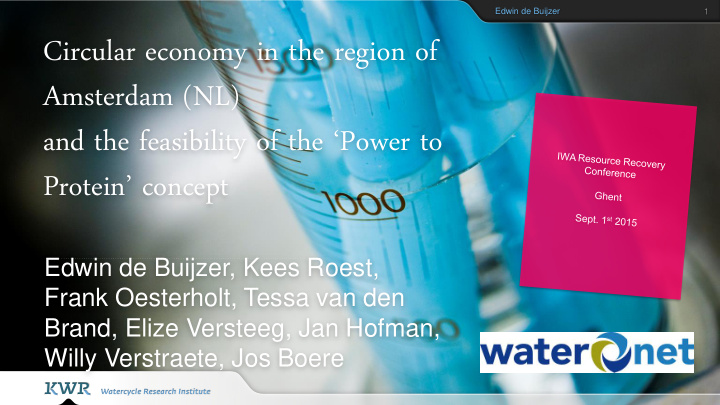



Edwin de Buijzer 1 Circular economy in the region of Amsterdam (NL) and the feasibility of the ‘Power to Protein ’ concept Edwin de Buijzer, Kees Roest, Frank Oesterholt, Tessa van den Brand, Elize Versteeg, Jan Hofman, Willy Verstraete, Jos Boere
Bridging science to practice 2 Outline of presentation • Introduction • Research target • Research design • Results • Flows • Strategy • Opportunities • Power to Protein: the concept • Power to Protein in Amsterdam • Outlook
Bridging science to practice 3 Introduction Circular economy in the region of Amsterdam • City of Amsterdam: 75% reduction of CO 2 emissions and total recycle of waste in 2040 • Waternet: energy neutral by 2020 and circular when possible Insight into and overview of the flow of urban resources related to the water cycle in the Amsterdam region is largely missing… to base strategic decisions on.
Bridging science to practice 4 Research target 1. Quantitatively map potentially valuable residual (waste) materials and flows (energy, water and raw materials) in the urban Amsterdam region 2. Examine processing techniques and routes in order to know how and where to recover and treat these resources in an optimal way 3. Investigate which resources are available for the application of the Power to Protein concept
Bridging science to practice 5 Research design Measurements Data extrapolation • Influent values 2 WWTPs Amsterdam (West & Translate (calculate) national and local data to the Westpoort) situation in Amsterdam • Effluent values 2 WWTPs Amsterdam For example: • Amount of landscape biomass in Amsterdam • Concentrations (certain) metals in effluent of WWTPs in Amsterdam
Bridging science to practice 6 Results: Quantities of potentially valuable residual
Bridging science to practice 7 Overview of potentially available flows A summary of the previous slide Resource Yearly flow (1.000 kg) Organic residuals > 197,492 Waste from the production of drinking water 27,406 Sludge wastewater treatment (dry matter) 26,283 Others, like: nutrients, metals, sand > 16,950
Bridging science to practice 9 The resource recovery strategy 1. Focus on recovery of critical raw materials (like phosphate) and (rare earth-)metals. 2. Recover resources with large quantities or with a higher value level (value pyramid). 3. For certain specific substances it is interesting to examine on short term the use and value: cellulose, fatty acids and lipids, thermal energy and residuals of drinking water production (especially humic acid).
Bridging science to practice 10 Opportunities, for: Production Research Others 1. Collect as much as possible of 1. Perform exploratory 1. Agreements for publishing and the organic residual flows of measurements of the measuring resources (in the Waternet (and others) to concentrations (rare/earth) same units) digest and produce biogas or metals in wastewater and green gas (energy), as long sludge of WWTPs. 2. Explore options for local as there is no technology (or marketing, like struvite as a market) for a higher value 2. Develop a standard method to fertilizer [is realised in june product. determine the amount of 2015] cellulose that can be collected 2. Collect fibers from biomass to at WWTPs. 3. Create a collecting system for produce building material, the intake of external organic and apply in your own 3. Develop a framework for the residual streams for processes. circulair economy, wider than fermenting, especially organic the CO 2 -footprint. waste from households in 3. Producing humic acids as Amsterdam. product for agriculture and horticulture. 4. Marketing humic acids as product for agriculture and horticulture.
Bridging science to practice 11 One of the ideas: Power to Protein Avecom/Willy Verstraete and Silvio Matassa May 2015; cover ES&T
Bridging science to practice 12 Concept Power to Protein Current situation, for Lithotroph hydrogen oxidizing bacteria example ammonium from reject water. Exploit off peak renewable energy to produce hydrogen and oxygen CO 2 from conversion (hydrogen economy). biogas to methane. In addition other sources in the city. Steam reforming of biogas is another option to produce H 2 and CO 2
Bridging science to practice 13 Power to Protein in watercycle of the city Amsterdam Potential and required resources Sources Avecom (2014) Amsterdam- WWTPs West Amsterdam (kg) reject water total potential (tonne/year) (tonne/year) Production SCP 1.000 6.300 24.000 required: ammonium NH 4 -N 196 1.235 4.670 from digestate by air stripping from bio-methane through steam hydrogen H 2 786 5.000 18.900 reforming from electrolysis of water using off peak green electricity Carbondioxide CO 2 3.309 21.000 79.400 from the production of bio-methane from biogas as a by-product of steam reforming process from an external source oxygen O 2 2.924 18.400 69.600 through aeration 35 % of the net yearly protein requirements of Amsterdam
Bridging science to practice 14 Outlook Available materials and flows in the urban Amsterdam region Resource recovery strategy The Power to Protein-concept in the watercycle of the city of Amsterdam
Bridging science to practice 15 Acknowledgement TKI funding from the Topconsortia for Knowledge & Innovation of the Dutch ministry of Economic Affairs My colleagues from KWR and our partners in these projects You, for your kind attention
Recommend
More recommend